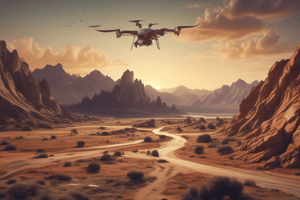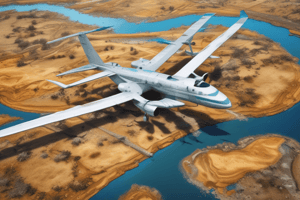Podcast
Questions and Answers
At high elevations, it's essential to stay hydrated because of the risk of overheating drone equipment.
At high elevations, it's essential to stay hydrated because of the risk of overheating drone equipment.
False (B)
When flying near power lines with a drone that has a visual positioning system, there may be issues with the drone's behavior.
When flying near power lines with a drone that has a visual positioning system, there may be issues with the drone's behavior.
False (B)
Compass interference can be resolved by returning to home immediately.
Compass interference can be resolved by returning to home immediately.
False (B)
Establishing pre-flight routines can help prevent issues and ensure a safe flight because it allows for the acquisition of telemetry information.
Establishing pre-flight routines can help prevent issues and ensure a safe flight because it allows for the acquisition of telemetry information.
Lack of telemetry information and distance data can indicate a problem with the drone's compass.
Lack of telemetry information and distance data can indicate a problem with the drone's compass.
Flashcards are hidden until you start studying
Study Notes
Free Flight Station
- The Free Flight station focuses on gathering facade data, which is the hardest part of mapping.
- To create detailed 3D textured meshes, multiple free flights are necessary to ensure a high level of overlap.
- The Pix4D free flight mode can be used, or DJI Go4 with time shots, but flying slowly is essential.
Flight Lines
- Flight lines should be done in odd numbers, similar to orbits.
- The first flight line should be below the awning, with subsequent lines at 15ft intervals.
- The camera should be tilted at no more than 15° to capture images.
Free Flight Mode
- In free flight mode, the horizontal slider should be set to 3ft, and the vertical slider to 6ft.
- The Sunny white balance setting should be used.
- The drone will snap an image every 3ft when moving horizontally.
Flying Techniques
- Start flying at line of sight, then use the screen to match the flight line and capture consistent data.
- When flying around corners and turns, make proportional movements and yaw slowly.
- Keep visual line of sight with the drone when flying.
- When mapping corners, take at least three images to ensure coverage.
Important Reminders
- No sky should be in the imagery, as this will affect the mapping process.
- Map what you can see, as this is the only way to create accurate models.
- At least 20% of the ground should be in the first layer of images to create manual tie points.
- Be careful when flying around trees and power lines, as these can cause problems with GPS.
Troubleshooting
- If the drone's red lights are not flashing, pause the mission and restart.
- If Pix4D overheats or the phone overheats, stopping the mission and starting a new one may be necessary.
- If issues occur during a mission, it may be necessary to create a smaller double grid to finish the original mission.
Competitive Advantage
-
Understanding the importance of capturing detailed models with no holes is a competitive advantage in mapping.
-
Creating beautiful, lifelike models requires a good understanding of acquisition strategies.### Drone Flight Safety
-
If drone equipment (e.g., Crystal Skies) is left in the heat, it can overheat and malfunction; to avoid this, keep equipment in the shade.
-
Lack of telemetry information and distance data can indicate a problem with the drone; in such cases, return to home immediately.
-
When flying near power lines with a drone that has a visual positioning system, there may be no issues; however, without VPS, the drone may behave erratically.
-
If a drone is experiencing compass interference ("toilet bowling"), land immediately and recalibrate the compass.
Best Practices
- Develop habits and routines, such as completing battery tests before taking off, to ensure successful drone operations.
- Establishing pre-flight routines can help prevent issues and ensure a safe flight.
Additional Tips
- At high elevations, it's essential to stay hydrated; consider using products like Liquid IV, which contains electrolytes and can help hydrate three to four times faster than water.
Free Flight Station
- Gathering facade data is the hardest part of mapping, and it requires multiple free flights to ensure a high level of overlap.
- Pix4D free flight mode or DJI Go4 with time shots can be used, but flying slowly is essential.
Flight Lines
- Flight lines should be done in odd numbers, similar to orbits.
- The first flight line should be below the awning, with subsequent lines at 15ft intervals.
- The camera should be tilted at no more than 15° to capture images.
Free Flight Mode
- In free flight mode, the horizontal slider should be set to 3ft, and the vertical slider to 6ft.
- The Sunny white balance setting should be used.
- The drone will snap an image every 3ft when moving horizontally.
Flying Techniques
- Start flying at line of sight, then use the screen to match the flight line and capture consistent data.
- When flying around corners and turns, make proportional movements and yaw slowly.
- Keep visual line of sight with the drone when flying.
- When mapping corners, take at least three images to ensure coverage.
Important Reminders
- No sky should be in the imagery, as this will affect the mapping process.
- Map what you can see, as this is the only way to create accurate models.
- At least 20% of the ground should be in the first layer of images to create manual tie points.
- Be careful when flying around trees and power lines, as these can cause problems with GPS.
Troubleshooting
- If the drone's red lights are not flashing, pause the mission and restart.
- If Pix4D overheats or the phone overheats, stopping the mission and starting a new one may be necessary.
- If issues occur during a mission, it may be necessary to create a smaller double grid to finish the original mission.
Competitive Advantage
- Understanding the importance of capturing detailed models with no holes is a competitive advantage in mapping.
- Creating beautiful, lifelike models requires a good understanding of acquisition strategies.
Drone Flight Safety
- Drone equipment should be kept in the shade to avoid overheating and malfunction.
- Lack of telemetry information and distance data can indicate a problem with the drone; in such cases, return to home immediately.
- When flying near power lines with a drone that has a visual positioning system, there may be no issues.
- If a drone is experiencing compass interference ("toilet bowling"), land immediately and recalibrate the compass.
Best Practices
- Develop habits and routines, such as completing battery tests before taking off, to ensure successful drone operations.
- Establishing pre-flight routines can help prevent issues and ensure a safe flight.
Additional Tips
- At high elevations, it's essential to stay hydrated; consider using products like Liquid IV, which contains electrolytes and can help hydrate three to four times faster than water.
Studying That Suits You
Use AI to generate personalized quizzes and flashcards to suit your learning preferences.




